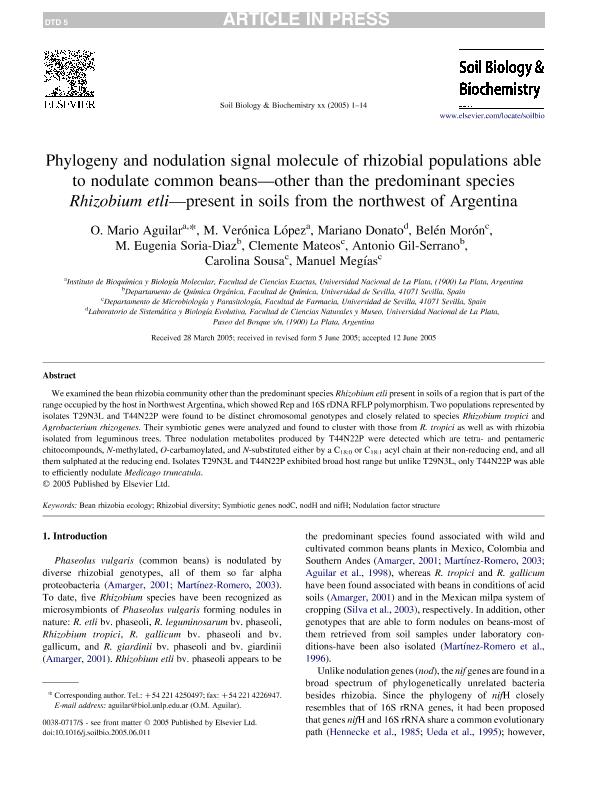Artículo
Phylogeny and nodulation signal molecule of rhizobial populations able to nodulate common beans—other than the predominant species Rhizobium etli—present in soils from the northwest of Argentina
Aguilar, Orlando Mario ; Lopez, Maria Veronica
; Lopez, Maria Veronica ; Donato, Mariano Humberto
; Donato, Mariano Humberto ; Morón, Belén; Soria Diaz, M. Eugenia; Mateos, Clemente; Gil Serrano, Antonio; Sousa, Carolina; Megías, Manuel
; Morón, Belén; Soria Diaz, M. Eugenia; Mateos, Clemente; Gil Serrano, Antonio; Sousa, Carolina; Megías, Manuel
 ; Lopez, Maria Veronica
; Lopez, Maria Veronica ; Donato, Mariano Humberto
; Donato, Mariano Humberto ; Morón, Belén; Soria Diaz, M. Eugenia; Mateos, Clemente; Gil Serrano, Antonio; Sousa, Carolina; Megías, Manuel
; Morón, Belén; Soria Diaz, M. Eugenia; Mateos, Clemente; Gil Serrano, Antonio; Sousa, Carolina; Megías, Manuel
Fecha de publicación:
12/2006
Editorial:
Pergamon-Elsevier Science Ltd
Revista:
Soil Biology And Biochemistry
ISSN:
0038-0717
Idioma:
Inglés
Tipo de recurso:
Artículo publicado
Clasificación temática:
Resumen
We examined the bean rhizobia community other than the predominant species Rhizobium etli present in soils of a region that is part of the range occupied by the host in Northwest Argentina, which showed Rep and 16S rDNA RFLP polymorphism. Two populations represented by isolates T29N3L and T44N22P were found to be distinct chromosomal genotypes and closely related to species Rhizobium tropici and Agrobacterium rhizogenes. Their symbiotic genes were analyzed and found to cluster with those from R. tropici as well as with rhizobia isolated from leguminous trees. Three nodulation metabolites produced by T44N22P were detected which are tetra- and pentameric chitocompounds, N-methylated, O-carbamoylated, and N-substituted either by a C18:0 or C18:1 acyl chain at their non-reducing end, and all them sulphated at the reducing end. Isolates T29N3L and T44N22P exhibited broad host range but unlike T29N3L, only T44N22P was able to efficiently nodulate Medicago truncatula.
Archivos asociados
Licencia
Identificadores
Colecciones
Articulos(CCT - LA PLATA)
Articulos de CTRO.CIENTIFICO TECNOL.CONICET - LA PLATA
Articulos de CTRO.CIENTIFICO TECNOL.CONICET - LA PLATA
Articulos(IBBM)
Articulos de INST.DE BIOTECNOLOGIA Y BIOLOGIA MOLECULAR
Articulos de INST.DE BIOTECNOLOGIA Y BIOLOGIA MOLECULAR
Citación
Aguilar, Orlando Mario; Lopez, Maria Veronica; Donato, Mariano Humberto; Morón, Belén; Soria Diaz, M. Eugenia; et al.; Phylogeny and nodulation signal molecule of rhizobial populations able to nodulate common beans—other than the predominant species Rhizobium etli—present in soils from the northwest of Argentina; Pergamon-Elsevier Science Ltd; Soil Biology And Biochemistry; 38; 3; 12-2006; 573-586
Compartir
Altmétricas



